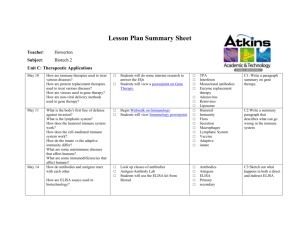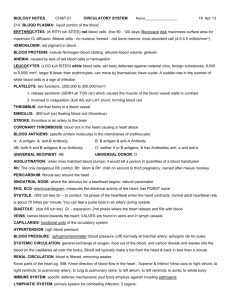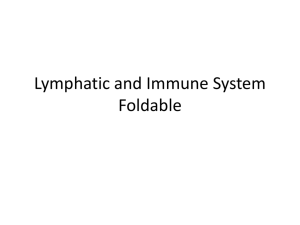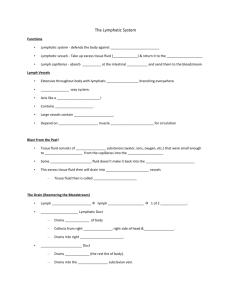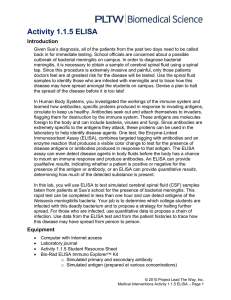Lab 7 The Lymphatic System and Immune Response
advertisement
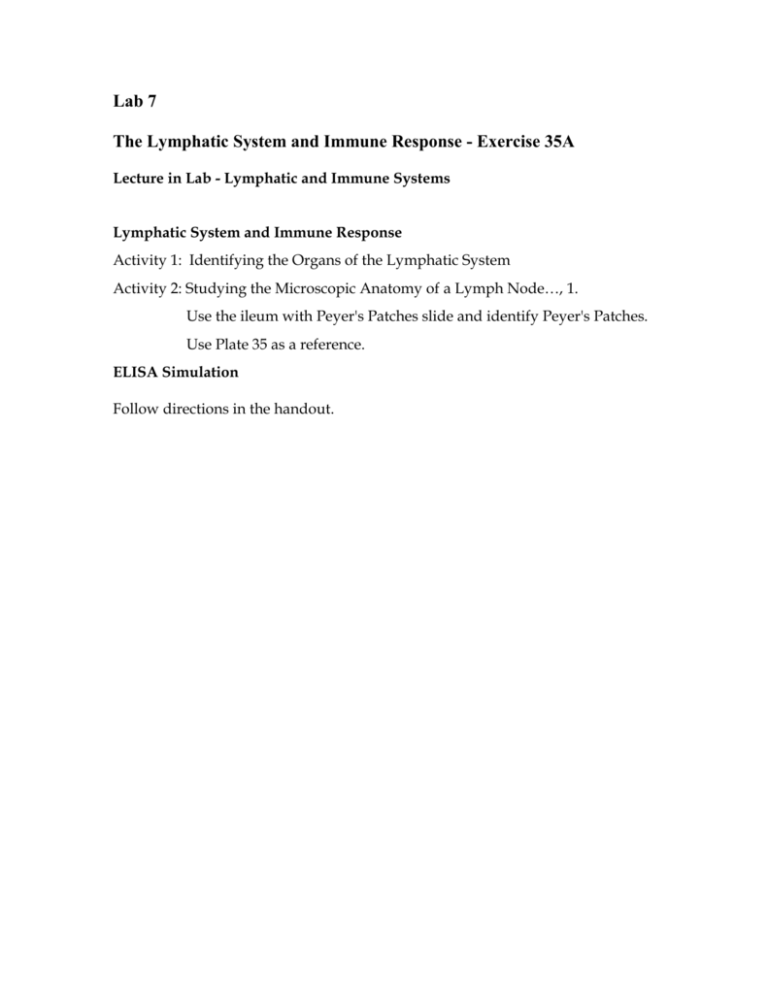
Lab 7 The Lymphatic System and Immune Response - Exercise 35A Lecture in Lab - Lymphatic and Immune Systems Lymphatic System and Immune Response Activity 1: Identifying the Organs of the Lymphatic System Activity 2: Studying the Microscopic Anatomy of a Lymph Node…, 1. Use the ileum with Peyer's Patches slide and identify Peyer's Patches. Use Plate 35 as a reference. ELISA Simulation Follow directions in the handout. ELISA Simulation (Adapted from Instructor’s Guide – Carolina Biological) This kit explores how the principles of antibody-based human immunity apply to a common laboratory test called ELISA (enzyme-linked immunoabsorbant assay). ELISA is commonly used to test blood serum for the presence of antibodies against disease-causing pathogens such as viruses and bacteria. This activity will investigate 6 patients for either HIV, Lyme Disease, Avian Influenza (Bird Flu) or West Nile virus. There is no risk of infection from any materials in this kit. Antibodies are a group of serum proteins (the Igs) that are in the blood or bound to cell membranes. Antigen binding sites fit the shapes of specific antigens. They bind in a lock-and-key manner to form antigen-antibody complexes (see Figure 1). ELISA is based on the principle that antibodies attach to their antigen targets with great specificity to form antigen-antibody complexes. This particular test is called indirect ELISA and tests the patient’s blood for antibodies to the infectious agent. The basic steps are outlined in Figure 2. 1. Proteins from the infectious agent are added to the wells of plastic microtiter plates. These antigens bind to the bottom of the plastic well. Unbound material is removed with a buffer wash. 2. Blood serum from the patient is added to the wells. If antibodies to the antigens are present they will bind to the antigen and form antibody-antigen complexes. The wells are again washed with buffer. You cannot see the antigenantibody complexes by eye, so detection steps are used to visualize them. 3. An antibody (secondary antibody) that recognizes human antibodies is added to the wells. If human antibodies are present the secondary antibody binds to the human antibodies (which in this case are the antigen!) and forms antigenantibody complexes. The wells are rinsed again with buffer. 4. The secondary antibody has an enzyme attached to it. This is called a conjugated antibody. When a special chemical called a chromogen is added to the wells, if the enzyme is present the chromogen changes color. The intensity of the color is related to the amount of antigen-antibody complex present. 5. No change in color indicates either no infection or no antibody response to the infection. 6. Samples are usually tested in triplicate to ensure reproducibility. Samples in clued positive and negative controls. The washes are very important and it is also important to use a clean pipet for each new sample or reagent. An Example of an ELISA test. Dark-colored wells indicate more antigenantibody complexes present than in lighter colored wells. Clear solution means no antigens present in the sample or no antibodies present in the serum. Name____________________________ Review Sheet Lab Section ________________ Turn in at the next Lab A B C D E F 1. Match the labels on the figure with the terms below. ___ Axillary nodes ___ Inguinal nodes ___ Cervical nodes ___ Right lymphatic ___ Cisterna chyli duct ___ Thoracic duct A B C D 2. Match the labels on the figure with the terms below. ___ Peyer's patches ___ Spleen ___ Thymus ___ Tonsils 3. What is the source of lymph in the lymphatic system? 4. How is lymph propelled through the lymphatic vessels? 5. Name two veins where lymph is returned to the circulatory system. a. ____________________________________ b. ____________________________________ 6. Describe two ways that lymph vessels are structurally similar to veins. a. b. 7. Why is lymph often cloudy or milky looking in the cisterna chyli? ________________________________________________________________________ C A D E B F 8. Match the labels on the figure with the terms below. ___ Afferent vessels ___ Capsule ___ Cortex ___ Efferent vessels ___ Germinal center ___ Medullary cords and sinuses 9. Why are there fewer efferent than afferent vessels? 10. If you are looking for the following immune system cells in a lymph node, where would you look? B cell ____________________________ T cell ____________________________ Macrophage ____________________________ 11. Match the following structures with the correct function. ___ B cells ___ Lymph node ___ Macrophage ___ Spleen ___ Thymus A. T cells develop self-tolerance and immunocompetence here B. Major site for presentation of antigens to B and T cells C. Removes damaged red blood cells and other debris from circulation D. Produce clones of antibody- producing plasma cells E. Large phagocyte which also acts as an antigen presenting cell ELISA Record your Group Data Here Questions 1. In what way is the ELISA assay similar to blood typing? 2. Why is this called an indirect method? In other words, how does it detect infection by a disease-causing agent? 3. What is the function of the secondary antibody and chromogen in an ELISA? 4. Why did you perform three identical tests for the control and patient samples? 5. Why might some positive results be lighter than others? 6. Describe the disease-causing pathogen you assayed for. Include its mode of transmission to people. 2 points 7. Evaluate your data. What is the diagnosis for each of the patients tested? A. B. C. D. E. F. 8. Did any of the outcomes surprise you? If so, why? 9. For patients who tested positive, how might they have prevented infection? Name __________________________________ Pre-Lab Questions – Respiratory System 1. The major role of the respiratory system is 2. Upper respiratory structures include the nose, the larynx and the a. epiglottis b. lungs c. pharynx d. trachea 3. The most prominent (largest) of the laryngeal cartilages is the ___________________ cartilage. 4. Air flows from the trachea into the right and left _________________________ . 5. What is the role of the respiratory epithelium in the trachea? 6. The main structural and functional units of the lungs are the _______________ . 7. In the human there are __________ lobes in the right lung and __________ lobes in the left lung. 8. When air passes out of the lungs it is called (circle one) inspiration expiration . 9. During normal quiet breathing about _________ ml of air moves into and out of the lungs. 10. The maximal amount of air that can be exhaled after a maximal inhalation is called ______________________________ .

